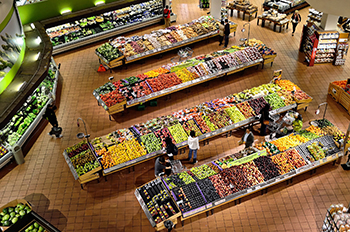John Ingram of the Environmental Change Institute at the University of Oxford discusses the different strategies for addressing food system resilience and the new opportunities that these can create in the food sector.
One of the great human achievements over the last half-century is that advances in global food production have largely kept pace with global demand. Today, around 6 billion people are not hungry, up from about 2 billion 50 years ago.
But there are still about 1 billion hungry people and at least 2 billion more lacking sufficient nutrients. There are also, paradoxically, more than 2.5 billion people who are overweight or obese. Gone are the days when malnutrition implied hunger.
On the face of it, this is the news we’ve been waiting for – fewer hungry people. But with population growth and increasing wealth in a strongly-emerging middleclass in many nations, food demand will continue to rise in coming decades as it has in the past fifty years.
Much of the change in food demand today is linked to urbanisation, with consumers having easier access to a wider range of ‘empty calories’ like cakes, crisps, burgers, and chips (ref 1). If diets for the increasingly-wealthy continue to move towards more processed foods there will be significant negative impacts on diet-related disease, such as diabetes and heart disease. We also know that this trend in current food system activities will continue to have a detrimental impact on the natural resource base. This means that, without radical changes to the methods of production, satisfying this increasing demand will lead to massive environmental degradation, further undermining the natural resource base upon which our food security depends (ref 2).
And it will be the poor and the marginalised who will be affected first and most severely.
The challenge ahead, then, is to achieve food security for a growing, wealthier, urbanising population, against a background of climate change and natural resource depletion, alongside changes in socio-economic-cultural conditions.
Some of these changes are gradual, like global mean temperature increase, sea level rises, and demographic changes. These can be thought of as ‘stresses’. Others changes are sudden, and include things like extreme weather events, financial market crashes, disease outbreaks, and conflict. These can be thought of as ‘shocks’.
So, how do we increase the resilience of this changing food system to withstand these stresses and shocks?
A resistant system
There are three widely acknowledged characteristics that would contribute to creating a resilient food system:
First, robustness: the food system needs to be able to resist disruption. For example, developing more heat-tolerant crops that will be able to resist drought, or strategic grain reserves and stronger food distribution infrastructure (like harbours and railways) in case transport links are cut-off, leaving communities isolated. This requires considerable political and financial investment.
Second, recovery: the food system needs the ability to recover and return to desired outcome following disruption. This might include re-instating crops or physical infrastructure, and emergency food distribution systems. Having a strong ability to recover requires contingency planning and funding.
Third, re-organisation: this is the ability to make changes in the food system in order to maintain the desired outcomes. Commonly termed ‘adaptation’, examples include changing farming systems, diversifying sources of primary ingredients, diversifying food chain operations, and better buffered market infrastructure. This requires a great deal of lateral thinking.
There is, however, a fourth way to think of resilience of food security outcomes: re-orientation: the ability to accept alternative outcomes.
A new diet
Understanding ‘re-orientation’ depends on considering carefully the food security definition: ‘when all people, at all times, have physical, social and economic access to sufficient, safe and nutritious food that meets their dietary needs and food preferences for an active and healthy life’ (ref 3).
Key words here are ‘sufficient’ and ‘preference’. Sufficient means enough for a given purpose, i.e. the right amount. Changing consumption patterns to reduce the physiologically-unnecessary (and unhealthy) over-consumption would increase food system resilience due to the system not having to produce so much food in the face of perturbations. Changing consumer preferences (in other words, accepting a different diet composition) would also increase food system resilience due to accepting a diet less dependent on either foods more susceptible to disruption, or which have high-environmental impact, thereby reducing the risk of undermining the long-term ability of the natural resource base to produce food.

Elements of ‘robustness’, ‘recovery’ and ‘re-organisation’ will all be important components of increasing food system resilience. However, an extrapolation of recent and current consumption patterns over coming decades due to increases in both population and wealth, together with the potential stresses and shocks, indicates that a radical shift in consumption patterns of the ‘over-consumers’ is needed (ref 4). So, while there is a clear need to develop more productive food producing systems that are more environmentally benign, a major advance also needs to be made in the demand side of the equation.
‘Re-orientation’ could also be seen as ‘transformation’ – and ultimately it is this that could prove to be the most important. In an age of urbanisation, increasing wealth, and easy access to processed foods with ‘empty calories’, consumer ‘re-orientation’ is vital in transforming the demands made on the food system more broadly in order to make it more resilient.
We therefore need to think of ways not only of how to better understand food system reactions to stresses and shocks, but also how to actively facilitate transformations and manage food system resilience with multiple goals in mind.
All four ways to consider resilience not only challenge the food sector but also offer tremendous opportunities: new methods for primary production; primary and secondary processing, marketing and retail; new, more environmentally-benign formulations aimed at emerging markets; and new professionals coming into the sector equipped with food systems ‘thinking’ to help maintain vibrant enterprises. Identifying and seizing these opportunities will be increasingly important as the nature of stresses and shocks become ever clearer.
Cross-government programme
It is against this background that ‘Global Food Security’, the UK cross-government programme on food security research, launched a £14.5 million set of projects under the banner ‘Resilience of the UK Food System in a Global Context’. With funding from BBSRC, ESRC, NERC and the Scottish Government, it aims to help policymakers and practitioners optimise the resilience of the UK’s food system to environmental, biological, economic, social and geopolitical stresses and shocks.
The three research themes are:
- Optimise the productivity, resilience and sustainability of agricultural systems and landscape
- Optimise the resilience of food supply chains
- Influence food choice for health, sustainability and resilience at the individual and household level.
Ten projects have been funded with research phase lifetimes up to 2020. While most are orientated towards Theme 1, some span a fuller ‘supply chain’ agenda. Ongoing integration of the individual projects’ results, in the context of changing information needs of a range of other stakeholders, will allow a much stronger understanding of how to enhance the resilience of the UK food system to guide policy and practice.
References
- Tilman, D. and M. Clark, 2014: Global diets link environmental sustainability and human health. Nature 515, 518-522.
- Westhoek, H., J. Ingram, S. van Berkum and M. Hajer, 2016: Food systems and natural resources. UNEP.
- World Food Summit, 1996. FAO, Rome.
- Ingram JSI. Look beyond production. 2017. Nature 544 S27.
About John Ingram
John Ingram, is the Food Systems Programme Leader at the Environmental Change Institute of the University of Oxford, South Parks Road in Oxford.
A version of this blog first appeared on 29 November 2017 in Food Science and Technology, the journal of the Institute of Food Science and Technology.



